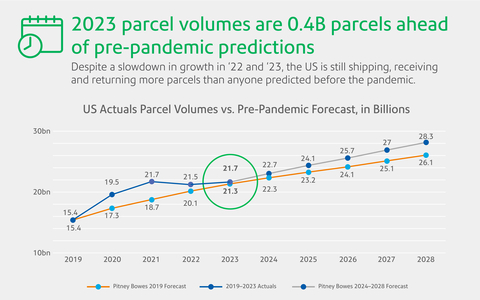Pitney Bowes Parcel Shipping Index: Consumer Demand for “Real-Time Retail” Shakes Carrier Market Share
- Amazon Logistics outperformed UPS and FedEx with a 15.7% volume growth.
- USPS maintained its position as the market leader in parcel volume.
- The carrier landscape is shifting towards smaller competitors with a focus on cost-effective shipping services.
- Pitney Bowes forecasts U.S. parcel volume to reach between 23 billion and 35 billion by 2029.
- U.S. parcel revenue declined slightly for the first time in 7 years.
- UPS and FedEx experienced declines in both parcel volume and revenue.
- Despite volume growth, Amazon Logistics remains fourth in market share by revenue.
- The decline in parcel revenue reflects high capacity built after the pandemic and intense competition.
Insights
U.S. Market Parcel Revenue Sees First Decline in Seven Years Despite Increased Parcel Volume

2023
Of the four largest carriers (USPS, Amazon Logistics, UPS, and FedEx), only Amazon Logistics grew volumes year-over-year, and by a staggering
Both Amazon Logistics and USPS experienced revenue growth, while UPS and FedEx declined in both parcel volume and revenue. Meanwhile, the “others” category comprised of smaller carriers witnessed substantial growth in revenue and volume. Although Amazon Logistics nearly tripled its shipping volumes from 2019 to 2023 (from 2B to 5.9B), it remains fourth in market share by revenue (
“Despite the continued aftershocks of the COVID-19 pandemic, persistent inflation, and pessimistic economic perceptions, consumer spending remains resilient, primarily via a growing demand for affordable goods from global marketplaces. The result is an influx of smaller, less-expensive, lightweight packages which drive up volumes at a lower rate of revenue-per-piece,” said Shemin Nurmohamed, EVP and President, Sending Technology Solutions at Pitney Bowes.
The four largest carriers shared more of the market with smaller competitors in 2023, as "other” carriers saw their combined volumes grow
“The legacy players are still adapting as the delivery landscape shifts to favor natively direct-to-consumer parcel networks that are designed from the start to serve residential deliveries, such as the USPS, Amazon Logistics and specialized/localized carriers,” said Vijay Ramachandran, VP of Go-to-Market Enablement and Experience at Pitney Bowes. “While parcel volume growth has shifted from double to single digits, consumers’ appetites for 'real-time retail,’ or affordable goods that are brought to market based on fast-moving trends, will continue to elevate parcel volumes well beyond the effects of the pandemic.”
Nurmohamed added: “As shippers gain access to an array of carrier options, multi-carrier platforms with recommendation engines help them identify and select the best carriers for their network and individual shipments, meeting customer demands efficiently and cost-effectively. It’s what Pitney Bowes is delivering for clients today.”
Carrier Volume
While
-
The USPS generated the highest parcel volume, at 6.6 billion parcels and down almost
1% from last year. -
This was followed by Amazon Logistics generating 5.9 billion parcels, up
15.7% from the previous year. -
UPS declined
10.3% from the previous year to 4.6 billion parcels. -
FedEx declined
6.1% from 4.1 billion in 2022 to 3.9 billion in 2023. -
The “others” category grew
28.5% in 2023, from 0.5 billion to 0.6 billion parcels.
Market Share by Volume
-
USPS continues to have the largest market share (
31% ). -
For the first time in the Index’s history, Amazon Logistics became the second provider with the largest market share (
27% ), surpassing UPS. -
UPS fell to third place with a
21% market share. -
The “others” category increased its share from
2% to almost3% of the market.
Carrier Revenue
In 2023,
-
UPS generated the highest parcel revenue of the major carriers at
$68.9 billion 6.4% year-over-year. -
This was followed by FedEx at
$63.2 billion 3.1% from last year. -
USPS increased
0.8% to$31.7 billion $31.4 billion -
Amazon Logistics grew
19% to$28.6 billion $24 billion 60% . -
The “others” category had the most significant revenue growth of
32.5% in one year, to$5.6 billion $4.3 billion
Market Share by Revenue
-
UPS had the largest parcel revenue market share, with
35% of the market, a2% decrease from 2022, followed by FedEx, with a32% share in 2023. -
USPS maintained its revenue market share of
16% . -
Amazon Logistics increased by two percentage points to
14% . -
The “others” category increased from
2.1% to2.8% .
Forecast
-
Pitney Bowes forecasts that
U.S. parcel volume will reach between 23 billion and 35 billion by 2029. -
The most likely scenario is that it will reach 29 billion with a
5% CAGR between 2024 and 2029.
About the Pitney Bowes Parcel Shipping Index
The Pitney Bowes Parcel Shipping Index measures parcel volume and spend for business-to-business, business-to-consumer, consumer-to-business, and consumer-consigned shipments that weigh up to 70
About Pitney Bowes
Pitney Bowes (NYSE:PBI) is a global shipping and mailing company that provides technology, logistics, and financial services to more than 90 percent of the Fortune 500. Small business, retail, enterprise, and government clients around the world rely on Pitney Bowes to reduce the complexity of sending mail and parcels. For the latest news, corporate announcements, and financial results, visit www.pitneybowes.com/us/newsroom. For additional information, visit Pitney Bowes at www.pitneybowes.com.
View source version on businesswire.com: https://www.businesswire.com/news/home/20240417690112/en/
Marifer Rodriguez
Director of Communications
marifer.rodriguez@pb.com
Source: Pitney Bowes Inc.







